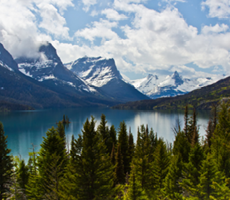- August 25, 2015
- By Liam Farrell
Allison Druin knows the value of preservation. Growing up in northern New Jersey, she didn’t have access to the geysers of Yellowstone or the rugged terrain of the Badlands, but she did have something just as amazing: the Thomas Alva Edison labs and home.
“It changed the way I thought about the world,” says Druin, a professor in UMD’s College of Information Studies and the university’s chief futurist. “National parks can do that.”
Today, Druin and her team are helping the National Park Service (NPS) design digital outreach for a new initiative aiming to increase elementary school visitors to all parks, public lands and water, and she has also been helping design new mobile technology for the Grand Teton National Park in Wyoming. In addition, she recently began a two-year leave of absence from UMD to serve as NPS’s special adviser for national digital strategy.
“It’s about connecting people to the land that, technically, they own,” she says. “It’s a wonderful moment, give the centennial celebration of the national parks, to stand back and take a look at what is needed for the future.”
Since 1998, Druin has led a design team at UMD’s Human-Computer Interaction Lab that brings together researchers and children ages 7 to 11, making her a natural fit as the NPS seeks to draw more children to the 58 national parks. The 2015–16 “Every Kid in a Park” program will give each fourth grader in the United States a free pass to visit one of the national parks, forests, refuges or historic sites.
Patrick O’Shea, UMD’s vice president for research, says this is a prime example of how faculty can take their expertise and affect the lives of real people.
“The national parks are all about families. (Druin) wants to create an experience,” he says. “This is a completely novel way of looking at national parks.”
Beth Bonsignore, a Ph.D. student in information studies, was one of the two graduate students who worked with Druin and a team of local children at Grand Teton National Park this summer. Over the two days and four design sessions, adults and children brainstormed apps, games, crowdsourcing opportunities and ways to communicate the park experience to kids who haven’t been there.
Working with children can be “messy,” Bonsignore says, but “it’s unsurprising that if you give them a chance, they will come up with a lot of surprising things.”
What came out of these design sessions includes the possibility of giving visitors more information about the vistas or animals they photograph with a smartphone and sharing the local knowledge that out-of-state and international travelers will lack.
For example, at Grand Teton, the local children quickly figured out trees were oddly cut near the top of their trunks because large amounts of snow had helped beavers reach them—something Druin was at a loss to explain.
“The technology can amplify the power of the park ranger,” she says.
With national parks ranging from Edison’s Labs to Seneca Falls, N.Y., the birthplace of the women’s rights movement, Druin says the most important task will be educating people on the narrative behind each one, from scientific invention to social justice.
“They all tell stories we need to hear,” she says.
Tags
Research